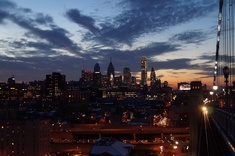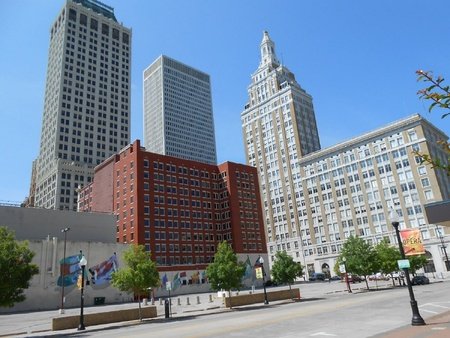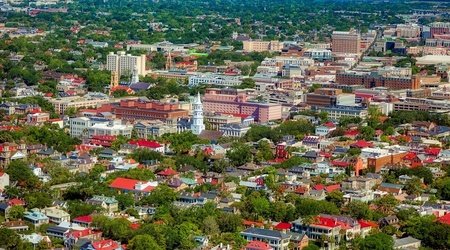
5 Facts About 5 States #8
Last updated: Wednesday April 13th, 2022
Report this blog
Oklahoma
Did you know that an oil well in Oklahoma erupted for 11 days before being contained? When the Mary Sudik No. 1 well erupted in 1930 after hitting a high-pressure formation about 6,500 feet beneath the state capital, the incident occurred. The well produced 20,000 barrels of oil and 200 million cubic feet of natural gas per day, which is incredible.
Before they were used anywhere else in the world, shopping carts were invented and used in Oklahoma. Sylvan Goldman, the owner of the Oklahoma City-based Humpty Dumpty supermarket chain, devised a plan to create shopping carts to aid his customers in their purchases. The cart's first prototype was based on a folding chair. The cart was officially launched on June 4, 1937. It was initially a flop, but with some advertising, the inventor was able to persuade shoppers to use the carts.
On March 25, 1948, the first tornado warning in the United States was issued in Oklahoma. Because the state is frequently hit by tornadoes, it is referred to as "Tornado Alley." Tornado Alley is a nickname for a region in the central United States' southern plains that has a high frequency of tornadoes year after year.

Oregon
Mill Ends Park, the world's smallest park, is located in Portland, Oregon. Surprisingly, the park only covers two square feet. Consider how a park could be squeezed into that small space. Here's a diagram to clear up any confusion. The park is located in the heavily traveled Naito Parkway's median. The Guinness Book of Records bestowed this honor on it in 1971. Because of a rumored sighting of a leprechaun, the park was built. Mill Ends was a column written by Dick Fagan, a journalist. He claimed (in jest, of course) to have witnessed a leprechaun digging a hole for the purpose of erecting a light pole. Fagan himself dedicated the park on St. Patrick's Day in 1948. The journalist also mentioned a leprechaun colony in the park, which was led by Patrick O'Toole.
Have you ever heard of a state that takes pride in its amazing geodes? Oregon's Thunderegg, on the other hand, will give you plenty of reasons to visit the state again. This official state rock is unique and appealing to the eye because it contains several minerals of various colors and crystalline structure. These popular items are apparently expertly cut and polished to reveal their stunning designs on the inside.
Because of its brightly colored appearance, Oregon sunstone is regarded highly as the state's official gemstone (designated in 1987). The stone is found primarily in the state's southeastern regions and belongs to the feldspar family. Sunstone is a variety of oligoclase, a mineral. Sunstone can be carved, polished, and faceted to create jewelry.
Crater Lake is a notable natural feature that distinguishes Oregon as a distinct state in the United States. Crater Lake is the deepest lake in the United States (592 meters) and one of the deepest in the world. The fact that it was formed thousands of years ago as a volcanic lake is the most intriguing aspect of its history. Every traveller in the world is familiar with its scenic crystal-blue waters. Even if you stacked the Eiffel Tower, Washington Monument, and Statue of Liberty on top of each other, Lady Liberty's torch would be covered by 100 feet of water. That is the depth of the lake.
Did you know that in eight states across the United States, including Oregon, physician-assisted suicide is legal? There are some restrictions to the act, such as the fact that the individuals must have a terminal illness and a prognosis of six months or less to live. Colorado, Hawaii, Vermont, Washington, Montana, California, and the District of Columbia are among the states that have legalized the act. Janet Adkins committed the first public assisted suicide in 1990.

Pennsylvania
Pennsylvania is home to the Liberty Bell, an iconic symbol of American independence. The Liberty Bell Center in Independence National Historical Park houses the bell. The Pennsylvania Provincial Assembly ordered the bell from London in 1751. At the first public reading of the Declaration of Independence, the bell was rung.
Bicycle Heaven, in Pittsburg, Pennsylvania, is the world's largest transportation museum dedicated to bicycles. Craig Morrow, the museum's founder, however, is a collector rather than a rider. Some of the bikes in his collection are worth more than $50,000, which is an interesting fact. The museum is free and open to the public seven days a week.
On June 23, 1998, at the University of Pittsburgh in Pennsylvania, the first transplant of human brain cells, known as neurons, was performed on a 62-year-old stroke patient. The patient's right arm and leg were both paralyzed. She also lost most of her ability to speak. The scientists hoped that the transplanted neurons would grow and replace the woman's brain's damaged neurons.
Philadelphia was the birthplace of terraced row houses in the United States. Sansom Street is still home to America's oldest row, named after its designer Thomas Carstair. At the time, row houses were a popular choice among home buyers. After the concept caught on with the general public, the row houses were dubbed "Philadelphia Row Houses," regardless of where they were built. If you live in a row house, you now understand where the concept came from!
Lancaster was the state capital for over a decade (1799–1812) before Harrisburg became the capital of Pennsylvania. The choice of Harrisburg as the state capital became obvious because the city was more centrally located, had access to a river, and the four acres of land donated by John Harris Jr. attracted the powers that be to make the move. Because of its central location, it allowed easy access from all parts of the state when other modes of transportation, such as cars and planes, were unavailable.

Rhode Island
Narragansett Bay receives water from Mount Hope Bay, which is fed by the Taunton River in Massachusetts. The bay has always been Rhode Island's most valuable asset, providing a navigable waterway that runs two-thirds of the state's length. The wealth of Newport, Bristol, and Providence was built on the commercial trade of the 18th century, which provided some of the capital for the state's industrial development in the 19th century. However, as Rhode Island became more industrialized, it exported very little from the bay. Coal, oil, automobiles, and other bulk goods were imported through this route. Although pollution limits the areas where shellfish are available, the bay has significant recreational uses and still supports a significant shellfishing industry.
The origin of the name Rhode Island is unknown. It was first applied to Aquidneck Island, a small island in Narragansett Bay named by Native Americans. The English settlers may have been confused between two foreign sources when they renamed Aquidneck as Rhode Island (a name that came to be used as shorthand for the entire colony) in 1644: Giovanni da Verrazzano's earlier comparison of Block Island to the Greek island of Rhodes, and the name Roodt Eyland (Red Island), which the Dutch had given to Aquidneck because of its red soil. The first settlement on the mainland, on Narragansett Bay, was named Providence Plantations by the state's founder, minister Roger Williams, who credited Divine Providence with bringing him safely there in 1636.
Rhode Island is drained by several river systems. The Blackstone, Pawtuxet, and Pawcatuck are the most important. The northern part of the state is drained by the Blackstone River and its tributaries. The Blackstone River, which originates in Massachusetts, once supplied waterpower to the textile mills built in Woonsocket, Pawtucket, and a dozen villages in between. The Pawtuxet River drains the state's central region. When the city of Providence built a dam at Kent in the 1920s, the river's north branch was flooded. The Scituate Reservoir, which supplies Providence and its surrounding communities, is now the state's largest body of fresh water. The Pawcatuck River flows west through the state's southernmost region into Block Island Sound, just south of Westerly.
Before English settlers arrived in the 1620s and 1630s, Native Americans had lived in the Narragansett Bay area for thousands of years. Prior to 1610, it is estimated that as many as 144,000 Indians lived in southern New England. The natives greeted the newcomers with open arms, but the diseases brought by the English would eventually kill a large portion of the indigenous population. Relations between the two groups were generally peaceful for the first 50 years of English settlement, but by the 1670s, the native peoples had been severely weakened by recurrent epidemics. As a result, the Native American population plummeted, and settlers stepped in to fill the void. During the next two centuries, the state of Rhode Island continued to lose land and population, to the point where the 1832 Rhode Island census counted only 80 Indians.

South Carolina
Spoleto, the state's annual arts festival, is one of the largest in the country. It takes place over the course of 17 days in Charleston, the largest city in South Carolina. Theatre and various types of music are at the heart of an entertainment program that enriches the area and draws hundreds of thousands of visitors from all over the world.
After South Carolina seceded from the Union, the state legislature adopted a flag on January 26, 1861. A white crescent in the upper left corner and a white palmetto in the center adorn the blue background of the flag. The palmetto was originally golden in color and surrounded by a white oval, but two days after the flag was adopted, it was changed to white and the oval was removed.
Georgia is not, contrary to popular belief, the Southeast's largest producer of peaches. Although we hear a lot about Georgia peaches (the state even has peaches on its license plates), South Carolina actually has more peaches than Georgia. California is still the country's top peach producer, but South Carolina came in second with 10,400 tons harvested in 2017. "We know Georgia gets all the credit, but SC actually harvests three times more peaches than GA," the South Carolina Department of Agriculture tweeted, mocking Georgia.

